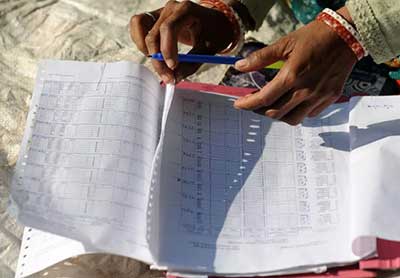Date: 14/04/2023
Relevance: GS-3: Indian Economy and issues relating to planning, mobilization, of resources, growth, development and employment.
Key Phrases: Microfinance, Joint Liability Groups, SHG, MFIs, Pradhan Mantri Mudra Yojana, PMSVANidhi, National Rural Livelihood Mission, Financial Literacy, Financial Inclusion.
Context:
- In order for MFIs to develop in underserved areas, financial literacy and credit delivery infrastructure must be enhanced.
Key Highlights:
- Access to financial services is essential for the economic development of a country, and microfinance has played a significant role in promoting financial inclusion by providing credit to the unbanked and underserved sections of society.
- In India, the microfinance sector has witnessed significant growth in the past decade, with over 15 crore households being serviced by various means, including microfinance institutions (MFIs), self-help group bank linkages, and joint liability groups (JLGs). The loan outstanding against these households is over ₹5-lakh crore.
- However, the growth of the microfinance sector is not uniform across the country, and it is concentrated in a few states.
Role of Microfinance in Promoting Financial Inclusion:
- The primary objective of microfinance is to provide access to
credit to financially excluded and underserved communities.
- Microfinance institutions such as MFIs target individuals and groups who do not have access to banking services due to several reasons, including lack of collateral, poor credit history, and other administrative issues.
- MFIs operate on a model that involves group lending, usually in the form of a joint liability group (JLG) or a self-help group (SHG), which reduces the risk of default and increases the chances of repayment.
- Microfinance has several advantages in promoting financial inclusion.
- Firstly, it provides access to credit to individuals and groups who otherwise would not have access to formal credit.
- Secondly, microfinance loans are usually smaller than traditional bank loans and are tailored to meet the borrower's specific needs. This makes them an affordable option for small business owners, farmers, and other low-income communities who require credit for working capital or other financial needs.
- Thirdly, microfinance promotes financial literacy and educates borrowers about financial management, which helps them make better financial decisions.
- MFIs, being crucial stakeholders in advancing financial inclusion, are enlisted as partners for government flagship programs like Pradhan Mantri Mudra Yojana and PMSVANidhi.
Challenges in Expanding Microfinance
- The microfinance sector in India has grown rapidly in recent years, but
its growth is not uniform across the country.
- For instance the data for 2021-22 shows that 82 per cent of the portfolio of microfinance sector is concentrated in 10 States and may be 100 districts.
- Five States — Bihar, Tamil Nadu, West Bengal, Uttar Pradesh and Karnataka account for 56 per cent of JLG portfolio.
- One of the major challenges in expanding microfinance services is
the lack of an enabling environment in some states.
- MFIs face regulatory hurdles in some states, which hinder their operations. This may be due to the complex licensing requirements or other regulatory restrictions imposed by the state government.
- Another challenge faced by the microfinance sector is the lack of infrastructure in some regions. The lack of physical and virtual connectivity in rural areas makes it challenging for MFIs to operate effectively.
- Moreover, the empowerment of women is another crucial factor that influences the growth of the microfinance sector. In regions where gender inequality is high, it may be challenging to persuade women to participate in microfinance activities.
- Another significant challenge is the lack of financial literacy among
microfinance borrowers.
- This makes it difficult for them to make informed decisions regarding borrowing and repayment, resulting in higher risks for the MFIs.
Expanding Microfinance to Underserved Regions
- The following are some steps that can be taken to promote the
growth of the microfinance sector in underserved regions:
- Conducive Regulatory Environment: State governments should
create a conducive regulatory environment that facilitates the growth of
the microfinance sector.
- The licensing process for MFIs should be simplified, and regulatory restrictions that hinder the sector's growth should be removed.
- Fiscal Incentives: Fiscal incentives such as tax exemptions can be provided to MFIs operating in underserved regions. This can encourage MFIs to expand their operations to these regions and promote financial inclusion.
- Financial Literacy Programs: Conducting financial literacy
programs for microfinance borrowers is essential to promote responsible
borrowing and repayment.
- The National Bank for Agriculture and Rural Development (NABARD) has organized several capacity-building programs for SHG members and MFIs.
- These programs help borrowers understand the importance of timely repayment, the need for savings, and the importance of creditworthiness.
- Infrastructure Development: Developing physical and virtual
connectivity in underserved regions is another crucial step in promoting
the growth of the microfinance sector.
- The government can provide subsidies for setting up infrastructure such as internet connectivity and transportation facilities.
- Conducive Regulatory Environment: State governments should
create a conducive regulatory environment that facilitates the growth of
the microfinance sector.
Conclusion
- Microfinance has significant potential in promoting financial
inclusion by providing credit to underserved communities.
- However, the uneven spread of the microfinance sector across the country poses a significant challenge.
- Enabling regulatory frameworks, fiscal incentives, and financial
literacy programs can encourage the growth of the microfinance sector in
underserved regions.
- Nevertheless, policymakers should ensure that the microfinance sector's growth does not come at the cost of borrowers' fair treatment and protection.
- A balanced approach is necessary to ensure that microfinance remains an effective tool for promoting financial inclusion in India.
Source: The Hindu BL
Mains Question:
Q. Explain the significance of microfinance in promoting financial inclusion in India. Discuss the challenges faced by the microfinance sector in expanding its outreach to underserved regions. Suggest measures that can be taken to promote the growth of the microfinance sector in these regions. (250 words).








